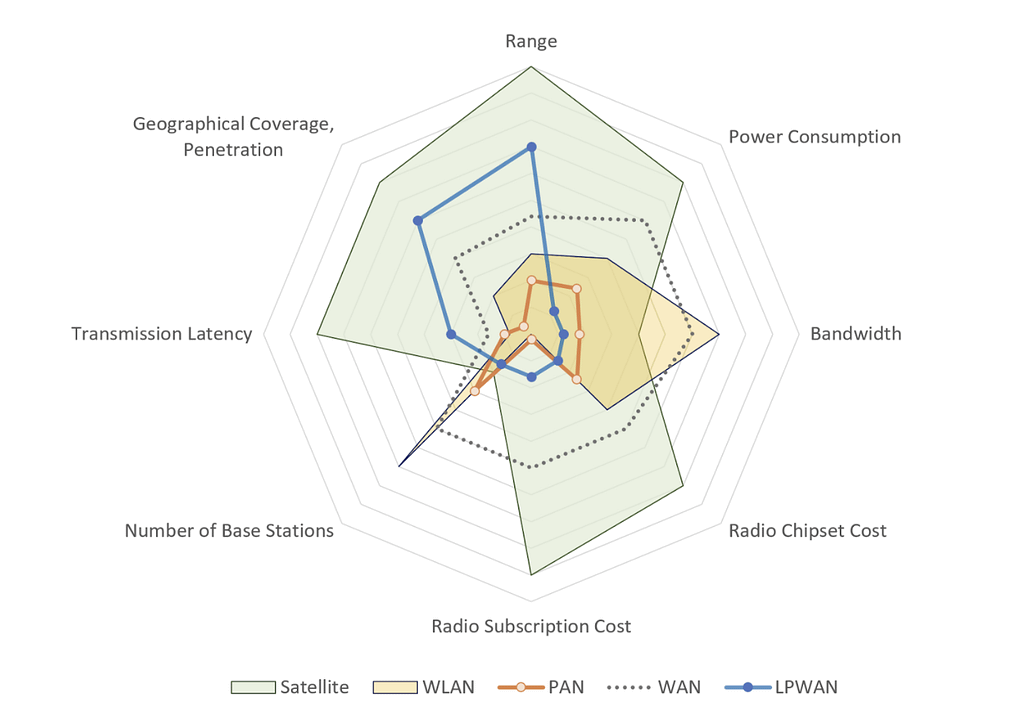The Internet of Things (IoT) has become an integral part of many operations and has disrupted business with improved productivity thanks to the monitoring and control of different processes. This interconnected web of devices has reinvented how mechanical, electrical, and electronic systems are used remotely.
Of course, the IoT ecosystem is a complex one, containing a myriad of providers, manufacturers, operators, developers, consultants, frameworks, and platforms all coexisting under the same banner.
For the purposes of this post, I am going to take a high-level view of the connectivity (transmission) layer of IoT – more specifically, the LPWAN (Low Power Wide Area Network) category, with a focus on NB-IoT.
What is NB-IoT?
NarrowBand-Internet of Things (NB-IoT) is a standards-based low power wide area (LPWAN) technology that enables a wide range of new IoT devices and services. NB-IoT significantly improves the power consumption of user devices, system capacity and spectrum efficiency, especially in deep coverage.
New physical layer signals and channels are designed to meet the demanding requirement of extended coverage – rural and deep indoors – and ultra-low device complexity.

At the transmission layer, several options exist. It’s important to explore all these options and narrow down your selection based on the criteria for your project, the main categories or connectivity options can be summarised into:
- LPWAN – Sigfox, LoRa, LTE-M, NB (narrowband)-IoT.
- PAN – Zigbee, Bluetooth, RFID, Thread.
- WAN (3GPP) – 2/3/4/5G.
- LAN – WiFi.
- Satellite – Starlink, Intelsat, etc.
It is important to consider the following when planning your IoT project.
Coverage area
The best place to start is by defining the coverage area and whether the end device will be stationary or mobile. If it needs to move around, what are the parameters? For instance, does it need to move locally (within an office); regionally, nationally, or even internationally? From a signal penetration perspective, do you require the devices to be indoors, underwater, underground, in a mine, basement, on land, or at sea?
Answering these questions will help you eliminate some connectivity options straight off the bat. For example, if you want to track a ship’s telemetry in real-time, something like 2/3/4/5G will not be an option due to its lack of ocean coverage.
Power efficiency
This is usually directly related to coverage, bandwidth and how often you need to transmit or receive information to/from the network. Power consumption on a Satellite receiver/transmitter will be really high and will typically need to be powered by a constant power source. On the other end of the spectrum LPWAN, if configured correctly, can offer sometimes up to 10 years on one disposable battery.
Scale
Given the potential for scale with IoT devices, you must consider if you are only going to connect a handful or hundreds of thousands of devices. Trying to connect 100 000 devices to a WiFi network will be neither technically nor economically feasible.
Cost
Cost is often related to the scale and value of the project or item. For 100 000 devices, you will need to get the price down to single-digit figures for it to make economic sense. But if it is only five ships you are trying to track, then the cost of the device becomes less relevant.
Bandwidth
Most IoT deployments do not transmit or receive a large amount of data. In general, these are sending out environmental (temperature, humidity, Co2 levels, and so on) or location data (GPS, base station ID, etc). This comes down to a few bytes per day with a low transmission rate requirement.

The LPWAN pattern (blue) in the radar chart above highlights its suitability for IoT deployments. Not only does it have the appropriate range, penetration, coverage, and power efficiency, but it also makes economic sense at scale.
If you decide to go the LPWAN route, there are several additional options within the category to keep in mind.
Each of these standards offers its own strengths and weaknesses. I might look at all the options at a later stage but for now, I will focus on NB-IoT. Saicom is offering this as a “switch on” service on all our Vodacom APN offerings.
NB-IoT
NB-IoT (also known by the clunkier moniker LTE Cat NB1) has been developed to enable a wide range of devices to be connected to the internet using existing mobile networks. This low power, narrowband technology can support small amounts of two-way data transmission in an efficient, secure, and reliable manner. This standard was created in 3GPP Release 13.
In Release 14, 3GPP introduced an enhanced NB-IoT protocol and a new device category called NB2. This is an upgraded version of the LTE Cat NB1 standard.
Irrespective, NB-IoT is one of the most significant connectivity technologies that will underpin many industrial-grade IoT deployments. It significantly improves the power consumption of user devices, system capacity, and spectrum efficiency, especially in deep coverage areas. But even though the first commercial NB-IoT launches were completed several years ago, it has yet to become part of the ‘mainstream’.
Fortunately, this is set to change as coverage in South Africa continues to grow.
Massive deployment opportunities
Statistics show that there are 127 new IoT devices connecting to the internet every second. By the end of this year, the number of IoT devices in homes will increase to 12.86 billion. Also, 40% of IoT devices will be used in the healthcare industry this year alone. By 2025, the IDC projects that there will be 41.6 billion connected IoT devices generating close to 80 zettabytes (ZB) of data. No matter how you look at it, that is a lot of data and a lot of opportunities for growth.
So why is NB-IoT such a big deal?
Well, it is characterised by excellent coverage, support of a massive number of connections, cost efficiency, low device power consumption, and optimised network architecture amongst others. By dramatically improving network efficiency and supporting a massive number of connections using only a portion of the available spectrum, the improved power consumption of devices will result in the aforementioned battery life of more than 10 years.
Excellent coverage
Most operators are deploying NB-IoT in the sub-1Ghz (1000Mhz) bands. For their part, Vodacom South Africa has deployed NB-IoT in L900–Band8. This has been live on Vodacom’s network since 2017 and they have been enabling base stations with NB-IoT ever since.
Effectively, this translates to far greater coverage per base station through an ultra-narrow bandwidth of only 180kHz. NB-IoT also offers an additional 20 dB of link budget, equating to roughly ten times the coverage of a normal base station.
All this means that signal penetration and propagation are far greater than traditional 2/3/4G networks giving you significantly more coverage than before.
Cost efficiency
Typically, NB-IoT devices send small payloads of data infrequently effectively minimising data costs. The devices themselves are also very cost-efficient.
Low power
NB-IoT devices are extremely power efficient (when using Power Saving Mode (PSM) together with Extended Discontinuous Reception (eDRX)). They revert to a low energy consumption sleep mode whenever possible. While in this state they are unreachable from the network – an important thing to keep in mind when designing your solutions.
An NB-IoT device is something that can be ‘installed and forgotten’. It just keeps operating and sending data back to the business back-end. This is one of the reasons why Saicom fully supports NB-IoT technology on our Vodacom APNs. We want to make it easier for companies to roll-out and maximise their investment in this more cost-effective IoT value proposition.
Industrial first
What makes NB-IoT especially appealing is how it delivers a better value proposition for industrial environments when compared to more traditional IoT technology.
It delivers coverage penetration in difficult environments making it ideal for challenging industrial deployments. The narrowband technology is not significantly affected by interference either. These devices have been designed to minimise hardware costs. Companies like Vodafone are forecasting that communications component costs will drop to $2 once full production is reached.
The low bandwidth of NB-IoT makes it ideal to transmit the few bytes of data many connected devices require to transmit daily. This contributes to making it more scalable at an industrial level than anything that has come before.
NB-IoT applications
NB-IoT is therefore perfect for any number of use cases. Think of smart agriculture, smart city applications (such as smart street lighting and waste management), smart meters, manufacturing automation, smoke detectors, and others. The robustness of the technology positions it strongly for Industry 4.0 where condition monitoring and predictive maintenance become integral components of industrial operations.
With NB-IoT connections predicted to approach 700 million by next year, up from 50 million when it launched in 2016, I believe it is critical to start capitalising on its growth potential and embrace this more innovative connectivity environment.



